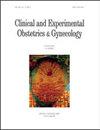TTR、PP13、PLGF联合检测对子痫前期患者的诊断价值
IF 0.6
4区 医学
Q4 OBSTETRICS & GYNECOLOGY
引用次数: 0
摘要
背景:探讨血清转甲状腺素(TTR)、胎盘蛋白13 (PP13)、胎盘生长因子(PLGF)对子痫前期患者的诊断价值。方法:回顾性选择2020年1月至2022年2月在我院检查的60例子痫前期孕妇为子痫前期组,同期在我院定期体检的健康孕妇40例为对照组。根据病情严重程度将患者分为两组:轻度子痫前期组(n = 35)和重度子痫前期组(n = 25)。比较各组血清TTR、PP13、PLGF水平。采用Spearman法分析血清TTR、PP13、PLGF与患者的相关性,并采用受试者工作特征曲线(ROC)及曲线下面积(AUC)分析单独及联合检测血清TTR、PP13、PLGF在子痫前期诊断中的临床价值。结果:子痫前期组血清TTR、PP13、PLGF水平明显低于对照组(p <0.05),轻度子痫前期组与对照组相比显著降低(p <0.05),重度子痫前期组明显低于轻度子痫前期组和对照组(p <0.05)。子痫前期患者血清TTR、PP13、PLGF水平与病情进展呈负相关(r = -0.332, -0.315, -0.391, p <0.05)。TTR、PP13、PLGF单独诊断子痫前期及联合诊断的AUC值分别为0.812、0.759、0.867、0.887。TTR、PP13和PLGF联合诊断子痫前期的ROC曲线下面积高于单独PP13 (p <0.05)。结论:与对照组相比,子痫前期患者血清TTR、PP13、PLGF水平均有所下降,且随病情加重下降更为明显,提示TTR、PP13、PLGF可作为预测子痫前期发病及严重程度的指标。三种指标的结合可提高诊断效率。本文章由计算机程序翻译,如有差异,请以英文原文为准。
Diagnostic Value of Combined Detection of Serum TTR, PP13 and PLGF in Preeclampsia Patients
Background: To investigate the diagnostic value of serum transthyretin (TTR), placental protein 13 (PP13) and placental growth factor (PLGF) in preeclampsia patients. Methods: Sixty cases of pregnant women with preeclampsia who were examined in our hospital from January 2020 to February 2022 were retrospectively selected as the preeclampsia group, and 40 cases of healthy pregnant women who received regular physical examination in our hospital during the same period were selected as the control group. Based on the severity of the disease, the patients were allocated into two groups: mild preeclampsia group (n = 35) and severe preeclampsia group (n = 25). The levels of Serum TTR, PP13 and PLGF were compared between the groups. The correlation between serum TTR, PP13, PLGF and the patients was also analyzed by Spearman method, and receiver operating characteristic curve (ROC) and area under the curve (AUC) was adopted to analyze the clinical value of the separate and combined detection of serum TTR, PP13, PLGF in the diagnosis of preeclampsia. Results: The levels of serum TTR, PP13, PLGF in preeclampsia group were evidently lower versus the control group (p < 0.05), and those of patients in mild preeclampsia group were markedly lower versus the control group (p < 0.05), while those in severe preeclampsia group were markedly lower versus the mild preeclampsia group and control group (p < 0.05). Serum TTR, PP13, PLGF levels in preeclampsia patients were negatively correlated with the disease progression (r = –0.332, –0.315, –0.391, p < 0.05). The AUC values of TTR, PP13, PLGF in the single diagnosis of preeclampsia and their joint diagnosis were 0.812, 0.759, 0.867, and 0.887, respectively. The area under the ROC curve of TTR, PP13, and PLGF joint diagnosis of preeclampsia was higher than that of PP13 alone (p < 0.05). Conclusions: Serum TTR, PP13, and PLGF levels of preeclampsia patients were decreased compared with those of the control group, and the decrease was more significant with the aggravation of the disease, suggesting that TTR, PP13, and PLGF could be used as indicators to predict the onset and severity of preeclampsia. The combination of the three indicators could improve the diagnostic efficiency.
求助全文
通过发布文献求助,成功后即可免费获取论文全文。
去求助
来源期刊
CiteScore
0.50
自引率
0.00%
发文量
241
审稿时长
1 months
期刊介绍:
CEOG is an international, peer-reviewed, open access journal. CEOG covers all aspects of Obstetrics and Gynecology, including obstetrics, prenatal diagnosis, maternal-fetal medicine, perinatology, general gynecology, gynecologic oncology, uro-gynecology, reproductive medicine, infertility, reproductive endocrinology, sexual medicine. All submissions of cutting-edge advances of medical research in the area of women''s health worldwide are encouraged.

 求助内容:
求助内容: 应助结果提醒方式:
应助结果提醒方式:


